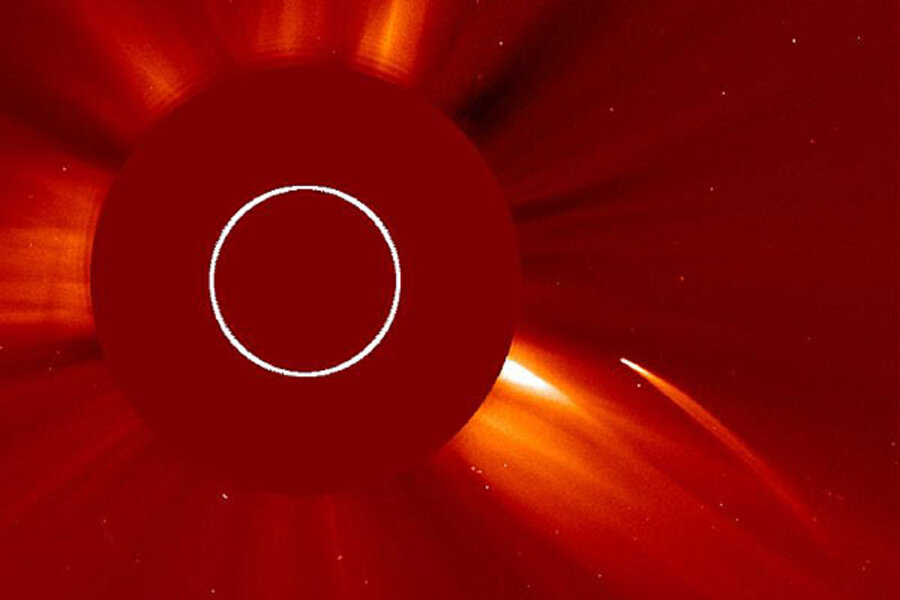Comet's fiery plunge may tell us how planets form
Loading...
For the first time, scientists have caught a comet in the Icarus-like act of zipping too close to the sun – and watched as it paid the ultimate price.
In catching a glimpse of the comet's final vaporization, researchers not only have been able to piece together a detailed picture of the comet itself – something usually reserved for spacecraft fly-bys. They also may have a found a way to use similar comets as test dummies for making key measurements of the sun's atmosphere, or corona.
And by throwing the break-up process into reverse, they may be able to answer a nagging question tied to the formation of planets in the solar system some 4.5 billion years ago: How does the clumping process that gathers tiny dust grains into ever bigger lumps and finally to planet-size objects really work?
The comet observations, published in the Jan. 20 issue of the journal Science, "are pioneering a new form of cometary study," writes Carey Lisse, a researcher at the Johns Hopkins University's Applied Physics Laboratory in Laurel, Md.
The comet, C/2011 N3, was discovered July 4, 2011, a scant two days before its demise, as researchers looked at data from the Solar and Heliospheric Observatory (SOHO) spacecraft, a joint NASA-European Space Agency project.
Sun-grazing comets, such as C/2011 N3, are nothing new to SOHO. It has observed more than 2,100 of them, according to NASA. It finds them with an instrument designed to mask the sun's disk so the instrument can observe the glowing corona.
But that's also a problem. Sun-grazers SOHO sees vanish behind this mask. And like Las Vegas, what goes on behind the mask stays behind the mask.
It took data from three craft – SOHO, as well as NASA's STEREO and Solar Dynamics Observatory – to piece together the full picture of C/2011 N3's final 20 minutes.
The C/2011 N3 belongs to a family known as Kreutz sungrazers – a vast collection of comet fragments thought to have come from the break-up of a larger comet around 2,500 years ago. Scientists estimate that the parent object's nucleus was as large as 60 miles across. Comet Halley, which makes its closest approach to the sun every 75 years, has a nucleus roughly 7 miles across.
Based on its observations, the team, led by Lockheed Martin Corporation solar physicist Karel Schrijver, estimates that C/2011 N3 was hurtling toward the sun at about 1.4 million miles an hour – fast enough to turn a three-day trip to the moon into a four-hour sprint. When it vanished, it had closed within 62,000 miles of the sun's surface.
The comet – with a nucleus up to 300 feet across and weighing about 70,000 tons – spawned a tail some 10,000 miles long during its final approach. Both the tail and the coma – an 800-mile-wide halo of dust and gas surrounding the nucleus – shone bright in the images the team gathered.
That in itself is a puzzle, according to Dean Pesnell, project scientist for the Solar Dynamics Observatory (SDO) at NASA's Goddard Space Flight Center in Greenbelt, Md.
The set of small telescopes on SDO that picked up the comet are designed to operate at wavelengths of light that correspond to temperatures of 1 million degrees, Dr. Pesnell says. Material that comes off the comet is around 300 degrees.
"You look at that and you say: I'm not ever going to see this stuff from a comet," he says.
Indeed, "we expected to see no other heavenly body" in the telescopes SDO uses, adds Pesnell, a member of the team that observed the comet's demise.
So why did C/2011 N3 shine so bright?
Researchers are looking at a couple of possible explanations: either material itself heats directly and quickly as the comet sheds it, or it heats and brightens the surrounding corona via friction.
Kreutz family comets are so numerous that they appear at the sun on average about once every three days. "We just need to get a couple more big ones" to help answer the question, Pesnell says.
These events also could help scientists reverse-engineer the vanishing comets to reveal in some detail how they are built. That, in turn, could shed light on initial processes that form comets, asteroids, and planets, suggests Johns Hopkins's Dr. Lisse.
Simulations and lab experiments suggest that tiny dust grains and gas molecules readily gather into clumps up to a half an inch across, he notes. But once they grow larger, they tend to crumble on contact with one another, or merely bounce off of each other. That should put a break on forming anything much larger than a mid-sized marble.
Yet with objects a half a mile across or larger, gravitational accretion goes to work building larger bodies. And the solar system is loaded with them – from small asteroids to Jupiter.
Deconstructing a comet may help explain how nature bridges this "aggregation gap," Lisse suggests.







